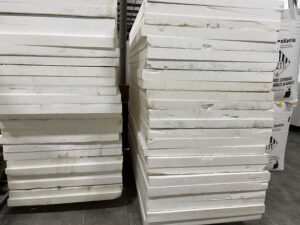Retrofitting Foundation Walls: A Guide to Choosing the Right Insulation
Comparing Exterior and Interior Foundation Insulation Approaches Retrofitting foundation walls involves different considerations depending on whether insulation is installed on the exterior or interior. Exterior insulation is generally preferred because…
The Circular Economy Starts at Home: Find a Contractor Who Champions Reclaimed Materials
The concept of a circular economy, where resources are kept in use for as long as possible, is gaining traction in many industries, and construction is no exception. As homeowners…
Enhance Your Home’s Energy Efficiency with Rigid Foam Insulation: A Comprehensive Application Guide
Improving home energy efficiency is crucial for reducing utility bills and creating a more comfortable living environment. Rigid foam insulation is an excellent solution, offering high thermal resistance and versatility.…
Green Building on a Budget: Massachusetts Energy Codes Meet Reclaimed Foam
Building a new home or undertaking a major renovation in Massachusetts comes with a hefty price tag, thanks in part to the rising costs of construction materials. But did you…
Reclaimed Foam Insulation: A Cost-Effective Solution for Retrofits
Revitalizing Older Buildings: The Power of Reclaimed Foam Panel Insulation for Energy Efficiency Older buildings, while often charming and full of character, frequently suffer from energy inefficiency due to outdated…
Reclaimed Foam Insulation Panels: Key Questions to Identify the Best Suppliers
As sustainable building practices gain momentum, sourcing high-quality reclaimed foam insulation panels becomes increasingly important. The success of integrating these eco-friendly materials into your projects hinges on partnering with a…
Efficient Insulation with Foam Panels: Key Applications and Green Benefits
To enhance the effectiveness of insulation in various parts of a structure, it is important to choose the right type of foam insulation panel. Here is an expanded guide on…
The Role of Reclaimed Insulation in Green Building Certifications
Green building certifications have become essential in promoting sustainability in construction. These certifications, such as LEED (Leadership in Energy and Environmental Design) and Green Globes, set standards for environmentally responsible…
Case Studies of Innovative Insulation Solutions
Here are some collections of resources for building professionals, homeowners, and anyone interested in enhancing the energy performance of buildings across diverse climates. These case studies and guides dive into…









